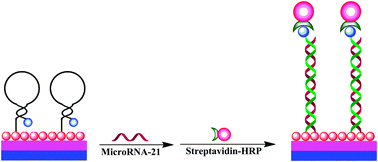MicroRNA-21 detection based on molecular switching by amperometry†
Abstract
A sensitive and selective

* Corresponding authors
a
College of Chemistry and Material Science, Shandong Agricultural University, 271018, Taian, Shandong, PR.China
E-mail:
yinhs@sdau.edu.cn, ashy@sdau.edu.cn
Fax: +86 538 8242251
Tel: +86 538 8247660
b Key Laboratory of Cell Proliferation and Regulation Biology of Ministry of Education, College of Life Science, Beijing Normal University, Beijing, PR. China
A sensitive and selective

 Please wait while we load your content...
Something went wrong. Try again?
Please wait while we load your content...
Something went wrong. Try again?
Y. Zhou, Z. Zhang, Z. Xu, H. Yin and S. Ai, New J. Chem., 2012, 36, 1985 DOI: 10.1039/C2NJ40253J
To request permission to reproduce material from this article, please go to the Copyright Clearance Center request page.
If you are an author contributing to an RSC publication, you do not need to request permission provided correct acknowledgement is given.
If you are the author of this article, you do not need to request permission to reproduce figures and diagrams provided correct acknowledgement is given. If you want to reproduce the whole article in a third-party publication (excluding your thesis/dissertation for which permission is not required) please go to the Copyright Clearance Center request page.
Read more about how to correctly acknowledge RSC content.
 Fetching data from CrossRef.
Fetching data from CrossRef.
This may take some time to load.
Loading related content
